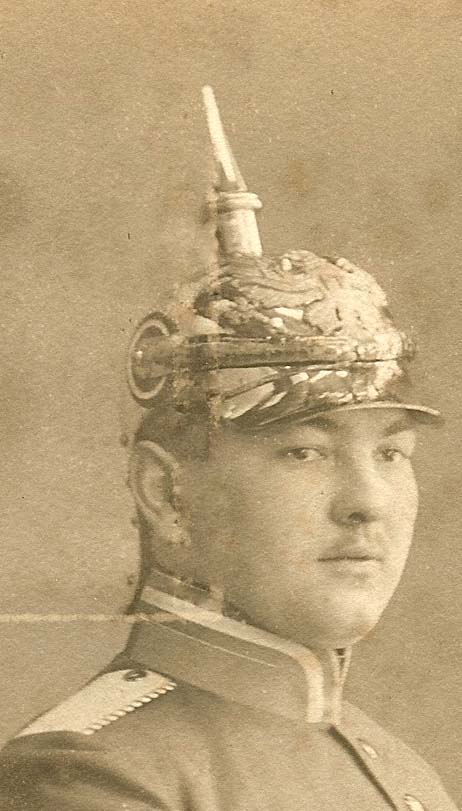Upgrading
Kürassier Helmets
Joseph P. Robinson.
December 1, 2005.
Collectors have struggled for quite some time
with the upgrading of the steel Kürassier helmets.
Only in the last several years has there been an understanding
of one year volunteer (OYV), Fähnrich and Fahnenjunker
for leather helmets. Metal helmets catch everyone's imagination,
and because officer or steel helmets are so very expensive,
few collectors have experience with these. The emergence
of the Neumann catalog has improved our understanding of
some nagging Kürassier problems.
This photograph from the Trawnik collection
shows a Saxon one year volunteer with a number of interesting
items on the helmet. First look at the front visor. The
one on the picture is known as a step visor. The cockade
has no silver ring and it is obviously a 65 mm cockade for
someone who does not yet have a portapee. The rosettes are
round, not trefoil. The spike base has a round ventilating
hole and not the design of the officer's helmet. The spike
is round not fluted. We know that a one year volunteer had
to privately buy the helmet so this was not issued. Can/would
this helmet be easily converted to officer rank?
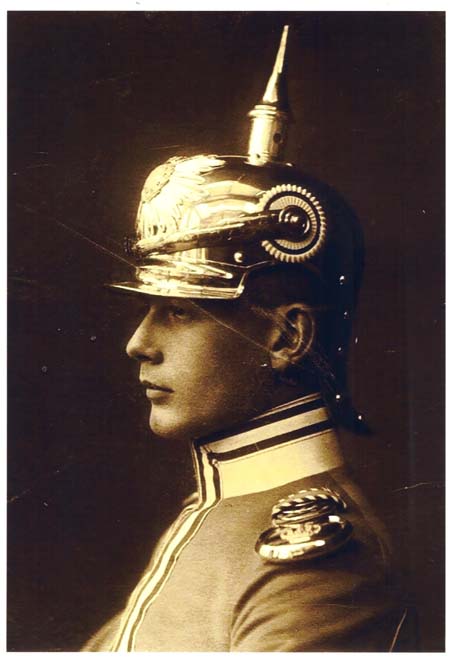
Let's take a look at the visors.
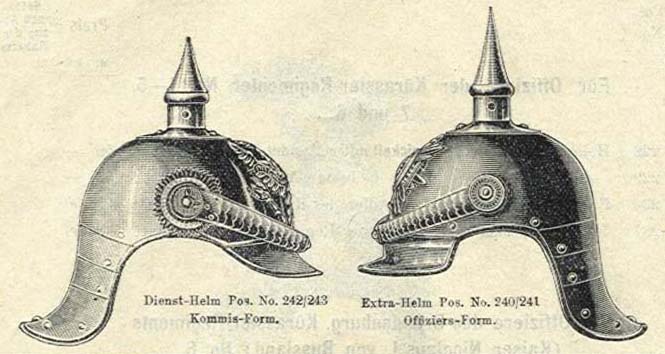
The one on the left is the model 1889. It
is known as Kommis-Form. It has a round front visor and
the spike is a bit shorter. The one on the right is a model
1867, is known as officer-form, has a step visor, a slightly
taller spike, and the back is more straight or vertical.
Much discussion in the past has centered on why an 1867
model helmet, would be used after 1889 for lower ranked
individuals who had not earned a portapee. Conversely, there
was not a lot of photographic evidence about those with
a portapee but not a commission. A lot of discussion centered
on the wear out date. Surely the older helmet styles would
not be discarded, and both styles would serve for quite
some time in a unit as the wear out date of a steel helmet
must be much longer than the 10 years of the leather helmet.
However, the helmet form on the right could be bought up
through the Junkers catalog in the 1930s.
Analysis has shown that there were four types of helmets.
The last three types were all private purchase helmets.
Individuals had to buy them from some sort of retailer.
Anyone could do it, including the lowest ranked soldier.
1. Issue helmets, also called Kammer quality. These steel
helmets can perhaps best be identified by finding a unit
mark stamped in one of various locations around the helmet.
2. Diensthelm. Also roughed steel helmets used by individuals
who had to individually purchase a helmet, such as a one
year volunteer or a Fahnenjunker. They were rough, identical
in many ways to an issue helmet and designed to be used
for every day and field duty. These are also called Eigentums
helm, extra helm, or extra-Kommis helm
3. A helmet for Fähnrich or Fahnenjunker. This would
be a high quality helmet with some, but not the entire galaxy
of officer upgrades. The intent was to upgrade this helm
to full officer when the individual was promoted to lieutenant.
4. Officer quality helmet. Used by a fully commissioned
officers from the rank of lieutenant through Colonel.
Issue helmets were the property of the state.
The Reichstag voted the money to buy them., the Reichstag
voted the money to replace them.. It was not the intent
of the unit or the state for individuals to upgrade an issue
helmet. Repairs made to the issue helmet were made by the
Bekleidings Instandsetung, a Corps level organization designed
to fix equipment. Issue helmets were consistently complained
about by the wearer as being heavy, poorly ventilated, and
chafing to the skull. Felt pads were placed in the top of
many steel helmets to stop them from rubbing the top of
the individuals head.
The Diensthelm was something needed by those
who could not get an issue helmet and were clearly not officers.
A one year volunteer needed a Diensthelm for everyday duties,
because the OYV was a low ranking enlisted individual. Some
OYV types could be commissioned as a reserve lieutenant
after two training periods in the reserve. That is after
his year of active duty. Many leather Diensthelms were converted
to reserve officer status directly. A few minor changes,
add a landwehr cross to the wappen and pop-you had an officer's
helmet. Not all Diensthelms were converted, and clearly
it was in the interest of the owner to have as high a quality
helmet as he could, if he was going to try to convert it.
There were so many changes in the Kürassier helm to
make a Diensthelm an officer helmet, that it was generally
not allowed.
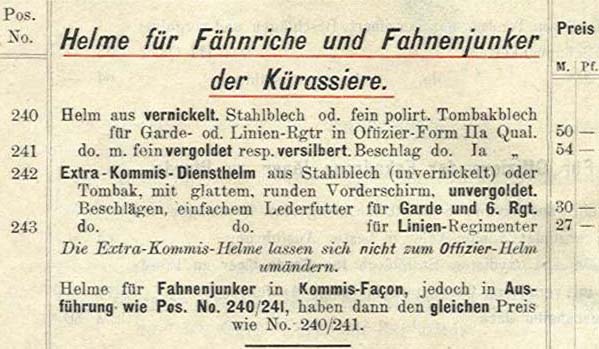
In this catalog there is a clear statement that saying Diensthelm
cannot be modified to an officer helm. . It shows the Diensthelm
was made out of steel that was not covered in nickel. Chin
scales, wappen and other fixtures that were not mercury
fire gilded.. It was possible to buy a Diensthelm in either
Kommis- form or officer-form.
The helmet for Fähnrich and Fahnenjunker's
was a higher quality helmet that had a nickel finish or
a fine polish for the tombak.. You could upgrade the Quality
of gilding or silver. These were only available in officer-form
and the liners were significantly different and better than
the old leather ones. These were fully convertible and upgradable
to full officer status. As shown below, the upgrade was
dependent upon the original condition of the helmet. Prices
were offered in different ranges for instance from 24-27
marks. You could either pay to have it changed over or you
could pay much more and have it renovated and changed over.
Cockades, rosettes, spike and base, might all be replaced.
While this would be a major upgrade it does not seem to
be too difficult to accomplish. In the matter of cockades
it does not appear as if there was an Unteroffiziere ohne
portapee specific cockade for metal helmets. It appears
as though it either had a silver ring denoting portapee
or it did not. Cockades for these helmets were all 65 mm.
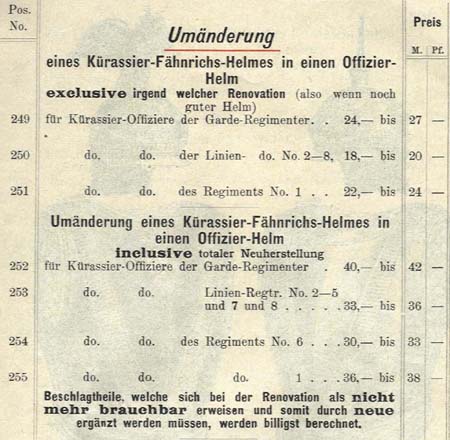
In addition to a total renovation, you could also get parts,
fixed. You could get your eagle re-silvered, your wappen
or chin scales fire gilded, or a liner installed. The commercial
market supported the requirements to keep the helmets in
top shape. As a comparison a new line Kürassier officer
helmet would cost in the low 60 Mark range.
So the main points of this are (Yes I know
this is based on only one catalog):
1. There were four kinds of Kürassier helmets.
2. Diensthelms in Kommis-form could not be converted to
officer-form
3. Diensthelms in officer form were not converted (Probably
because of the lack of nickel in the shell.)
4. There were three different kinds of. Private purchase
helmets that was quite different.
5. Step visored helmets could be bought at any time.
